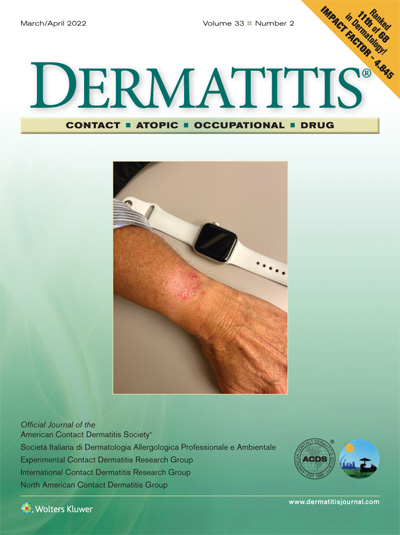Aggregate Response Benefit in Skin Clearance and Itch Reduction With Upadacitinib or Dupilumab in Patients With Moderate-to-Severe Atopic Dermatitis.
IF 3.2
3区 医学
Q1 DERMATOLOGY
引用次数: 0
Abstract
Background: In patients with moderate-to-severe atopic dermatitis (AD), greater skin clearance and itch reduction are associated with more pronounced improvements in quality of life (QoL). Objective: To characterize the aggregate response benefit with upadacitinib versus dupilumab or placebo in patients with moderate-to-severe AD. Methods: Degree of skin clearance and itch response in 3 phase 3 studies (Heads Up [NCT03738397] and Measure Up 1/2 [integrated; NCT03569293/NCT03607422]) were assessed by the Eczema Area and Severity Index (EASI) and Worst Pruritus Numerical Rating Scale (WP-NRS), respectively, using mutually exclusive categories. The aggregate response benefit with upadacitinib over dupilumab or placebo was determined by summing incremental differences for each EASI or WP-NRS category across the full distribution of patient responses. Results: Comparisons across EASI improvement threshold distributions, EASI severity levels, and WP-NRS categories demonstrated an aggregate response benefit favoring upadacitinib over dupilumab as early as week 4 and continuing at weeks 16 and 24. Similar trends were observed for upadacitinib 15 and 30 mg versus placebo. Conclusions: The aggregate response benefit in skin clearance and itch reduction favored upadacitinib 30 mg over dupilumab and upadacitinib 15 or 30 mg over placebo. These benefits may translate to overall greater improvements in patient QoL.中度至重度特应性皮炎患者使用乌达帕替尼或杜比鲁单抗可获得皮肤清除率和瘙痒减轻率的综合应答获益
背景:在中重度特应性皮炎(AD)患者中,皮肤清除率越高、瘙痒程度越轻,生活质量(QoL)的改善就越明显。研究目的描述中重度特应性皮炎患者使用达帕替尼相对于杜比鲁单抗或安慰剂的总体反应获益情况。方法在3项3期研究(Heads Up [NCT03738397]和Measure Up 1/2 [整合;NCT03569293/NCT03607422])中,通过湿疹面积和严重程度指数(EASI)和最差瘙痒数字评定量表(WP-NRS)分别评估皮肤清除程度和瘙痒反应,采用相互排斥的类别。达帕替尼相对于杜比鲁单抗或安慰剂的总体应答获益是通过在患者应答的全部分布中求和每个EASI或WP-NRS类别的增量差异来确定的。结果对不同的EASI改善阈值分布、EASI严重程度和WP-NRS类别进行比较后发现,早在第4周时,达帕替尼就比杜比鲁单抗更有总体应答优势,并在第16周和第24周时持续存在。达帕替尼 15 毫克和 30 毫克与安慰剂相比也观察到类似的趋势。结论在皮肤清除率和瘙痒减轻方面,达达替尼30毫克优于杜比鲁单抗,达达替尼15或30毫克优于安慰剂。这些益处可能会使患者的 QoL 整体上得到更大改善。
本文章由计算机程序翻译,如有差异,请以英文原文为准。
求助全文
约1分钟内获得全文
求助全文
来源期刊

Dermatitis
医学-皮肤病学
CiteScore
5.30
自引率
11.50%
发文量
251
审稿时长
>12 weeks
期刊介绍:
Dermatitis is owned by the American Contact Dermatitis Society and is the home journal of 4 other organizations, namely Societa Italiana di Dermatologica Allergologica Professionale e Ambientale, Experimental Contact Dermatitis Research Group, International Contact Dermatitis Research Group, and North American Contact Dermatitis Group.
Dermatitis focuses on contact, atopic, occupational, and drug dermatitis, and welcomes manuscript submissions in these fields, with emphasis on reviews, studies, reports, and letters. Annual sections include Contact Allergen of the Year and Contact Allergen Alternatives, for which papers are chosen or invited by the respective section editor. Other sections unique to the journal are Pearls & Zebras, Product Allergen Watch, and news, features, or meeting abstracts from participating organizations.
 求助内容:
求助内容: 应助结果提醒方式:
应助结果提醒方式:


